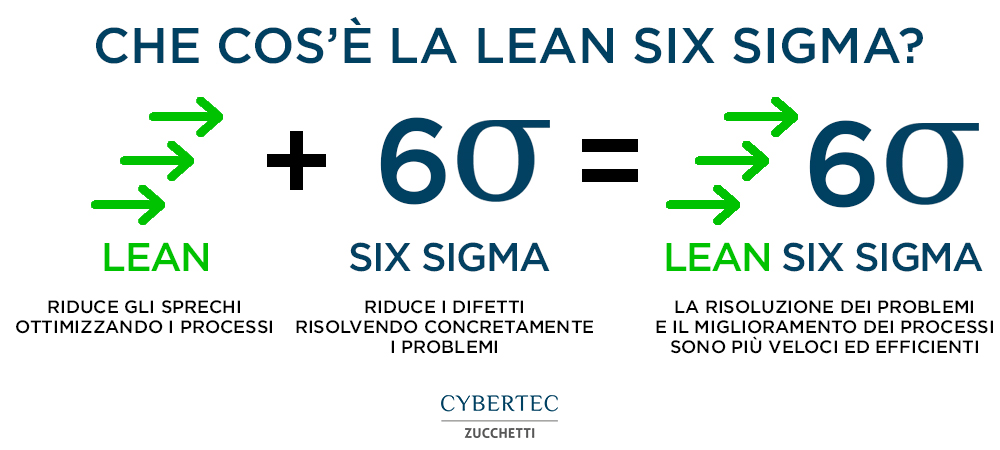If you work within manufacturing companies then you probably do, but not everyone knows what this term means.
Let’s discover the origin and meaning of this methodology first introduced in the second half of the eighties by Bob Galvin and Bill Smith and spread initially in Motorola and later in other important companies, such as General Electric, Toyota, Honeywell and Microsoft.
Whatis Lean Six Sigma?
It is a very powerful approach tool to increase company competitiveness that comes from the synthesis of two methodologies, Lean and Six Sigma.
Lean Six Sigma, also known as Lean Six Sigma or Lean 6σ is a modern and extremely rigorous methodology in the management of organizations that aims to achieve excellence, optimization and minimization of waste.
The LSS is focused on 7 key principles:
- Customer focus;
- Identify and understand how the work is actually done and what the value stream is during the process;
- Organise, improve and make the process flow more fluid;
- Removal of waste and unnecessary steps (i.e. that do not bring added value);
- Decisions are made based on facts and always make the process more robust;
- Involvement of people in the process improvement project;
- Address all improvement activities in a systematic and structured manner.
In particular, it is a quality management program that is based on the control of the mean square difference with the aim of bringing the quality of a product to a certain level, particularly favourable for the final consumer.
The objective of the Lean Six Sigma method is to achieve a control of the production process such as to reach 3.4 defective parts per million units produced.
The variability of the production process is therefore extremely limited, which is why initially the common opinion was that it was impossible to achieve, however some industries and sectors have shown that such a goal is achievable.
The progress offered by this method is due to the fact that it aims at eliminating defects and waste rather than simply improving average performance.

What is the Lean Six Sigma for?
During the seventies and the first half of the eighties, many companies active in the technology sector experienced rapid and constant growth, which combined with the considerable availability of technological resources gave them the opportunity to continuously innovate their products in a short time. The scenario was one of fierce competition in terms of technological innovation, in which attention was increasingly directed towards the design and implementation phase of the product with the tendency to neglect customer expectations. There was therefore an awareness of an imminent disconnection of products from what were the needs of the consumer and therefore the intuition on the part of some companies that it was important that technological progress was accompanied by meeting the needs of customers, which had to be accepted and overcome.
What is the Lean Six Sigma methodology?
Quality is inversely proportional to variability and consequently the improvement of quality is given by the reduction of product variability and the reduction of waste. In short, variability is our “enemy” and therefore the Lean Six Sigma methodology has as its main objective to reduce it. According to this methodology, the objective to be achieved is to have 6 standard deviations between the production centre and the upper and lower specification limits. On this basis, we can talk about the DMAIC Algorithm for the improvement of existing processes or the DMADV Algorithm for the re-engineering or creation of a new production process.
DMAIC Algorithm:
- Define: the working group must identify the product to be improved, translate the customer’s needs into requirements (or CTQ – Critical to Quality), identify the participants and develop high-level planning;
- Measure: evaluation of the current performance level with reference to the requirements identified in the previous phase. The current sigma level can also be calculated to compare the results with the required standards;
- Analyze: on the basis of the measured data, statistical techniques are applied to identify the causes of the defects and to quantify to what extent each cause (or the interaction between them) influences the studied requirement and its variance;
- Improve: Improvements are proposed and put into practice, after thoroughly understanding the causes of the defects.
- Control: In this phase the process is controlled, in order to standardize and stabilize it.
To these were subsequently added:
- Recognize: development of the intervention strategy, (zero level of the DMAIC);
- Standardise: definition and coding of best practice, (level six of the DMAIC);
- Integrate: complementary actions to support the philosophy adopted, (level seven of the DMAIC).
DMADV Algorithm:
- Define (Define) the process and identify where it may not meet the expectations of the customer and the company strategy;
- Measure the process and determine if it meets the customer’s expectations;
- Analyze the options necessary to define alternatives;
- Design (Design) improvement changes to the process in order to satisfy the customer;
- Verify that the improvements have met the customer’s expectations.
This approach is known by the acronym DMADV, from the initials of the various steps which are closely linked to what the customer wants from the product or service.
Tools to support Lean Six Sigma for production processes
Lean Six Sigma is an excellent methodology but it can be complex to maintain and therefore requires tools to support what is effective and support also in the management of production processes.
From the LSS perspective, CyberPlan is the Design and Verify tool of the production programming process.
Thanks to its process modeling and simulation, it not only allows you to intervene dynamically and efficiently, but also becomes the tool on which to base the engineering of the process and therefore make it robust and efficient.
In summary, it answers the typical questions of Lean Six Sigma, namely:
- Customer-focused: delivery time and order completeness.
- It models how the work is actually done and what the value stream is during the process.
- Organize, improve and make the flow of the process more fluid.
- Identify waste e.g. of availability and bottlenecks (i.e. what does not bring added value).
- It proposes solutions based on facts, through simulation.
- Involves people in the process improvement project. In fact, a planning project requires the involvement of people, from planning to sales, through production, purchases, etc.
- It allows you to address all improvement activities in a systematic and structured way.
This article was created with the valuable contribution of Eng. Maurizio Panighello, Black Belt Lean Six Sigma and founder of Thera, a business consulting company, software developers and long-time Cybertec partners.
Learn how to improve your production process
Contact an expert in the field of Supply Chain and find out how to increase the performance of your production. Find out how CyberPlan software, which uses the Agile methodology, allows you to plan and schedule production in an advanced way, respecting Lean and Six Sigma methodologies. Contact us without obligation.
